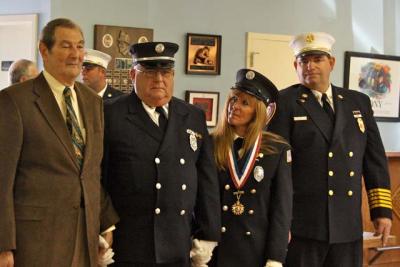Big Trucks on Small Lots
Big Trucks on Small Lots
The East Hampton Town Board held hearings last Thursday on legislation designed to address complaints about commercial vehicles — work trucks and other equipment — parked on residential lots, largely in Springs. The board found, however, that its proposed solution — to allow two commercially registered vehicles of up to 14,000 pounds gross vehicle weight — did not sit well with a number of speakers.
A second proposed law would prohibit the parking of commercially registered vehicles on residential streets between midnight and 6 a.m.
Councilman Peter Van Scoyoc, who originally introduced the parking proposal, said he had asked to withdraw it but had been overruled by a board majority. He said he had realized that “one size doesn’t fit all,” in terms of what might be appropriate on properties of different sizes, and called for a study group to examine the issue further and return to the board with suggestions.
There is a law on the books excluding most businesses from residential areas, but it has been difficult to enforce as far as the parking of commercial vehicles, according to Pat Gunn, the head of the town’s Public Safety Division. Mr. Gunn has been telling the town board for two years that the law, which allows only parking of “light trucks” on residential lots, lacks a definition of that term.
Regardless of the law, Supervisor Bill Wilkinson said that “we had never put the people that use their driveways on notice that this is unacceptable . . . so I think it’s an obligation on our part” to offer business owners another place to park their trucks, “because what had been acceptable is no longer acceptable.”
“I stress ‘residential,’ ” said Connie Kenney, a Springs resident. Some professional home-based businesses are allowed under the town code, she noted, “but running a masonry business or a landscaping business that requires large trucks is unacceptable in a residential neighborhood.”
Parking “anything more than what we would all refer to as a pickup truck” should not be allowed, she said. “The people of Springs need immediate relief from what we consider to be a flagrant lack of concern to the rights of homeowners.”
She displayed photos of equipment, such as a wood chipper, that she said was regularly stored on roadsides and on dead-end roads.
Neil Zelenetz, also of Springs, told the board that “we have high taxes . . . reduced services . . . overcrowding . . . a lack of code enforcement. Various town boards over the years have been ineffective at limiting or reversing these trends . . . it’s a no-brainer to not have large vehicles, or even medium-size vehicles on the streets or in driveways. If they’re in business, they’re in business. They should have a place to operate their business.”
Fred Weinberg agreed. “The storage of trucks and equipment is a standard cost of doing business,” he said. “We the homeowners are in essence paying for what they’re not paying for, and at a much larger cost,” in declining property values.
When there is no more room in driveways or on lawns, David Buda said, people use the streets nearby. “They simply appropriate the public’s right of way to park their vehicles.”
“I’m not saying that there should be no commercial vehicles” at residences, said Mr. Buda. “It’s a question of size, and what is excessive.” In his opinion, he said, “a dump truck is beyond the pale. A van and a pickup truck should be allowed. But the business grows; the trucks grow.”
He said the town’s legislation should also apply to trailers.
The 14,500-pound maximum is “way too much,” according to Martin Drew of Springs, who said commercial vehicle parking is “becoming a blight.”
“When it’s registered as a commercial vehicle . . . it doesn’t belong in a residential neighborhood,” he said, suggesting instead that there should be “truck farms” in every hamlet. The issue, he said, is the number and activity of workers coming and going in residential areas.
Rita Wasserman of Springs also said the proposed rule was too liberal. “I’m thinking no trucks,” she said.
Carol Buda said the limit under discussion was “an ill-conceived resolution in response to our complaints.” Because of the “board’s lack of action,” she said, “the truck issue has become noticeably worse.” The town board, she said, “has failed to put the residential code first.”
But Iris Osborne, a Wainscott resident, told the board that “you have to consider the working people.”
“These working people are not rich; they don’t have a lot of money. Maybe they can’t afford to rent a place to keep their trucks. Because they have a commercial license, you’re going to say they can’t park in their own driveway?”
Ms. Osborne agreed, however, that a ban on street parking was reasonable, and that parking “lots and lots” of vehicles and equipment at a residence could be unacceptable.
One issue, she said, with centralized parking lots for work vehicles, could be security. People park their equipment close to their houses, she said, to guard against theft.
Rather than trying to change the relevant section of the town code completely, Ms. Buda suggested that the board should perhaps have stuck to the simpler solution originally suggested by Mr. Gunn: simply provide a definition of “light truck.”

